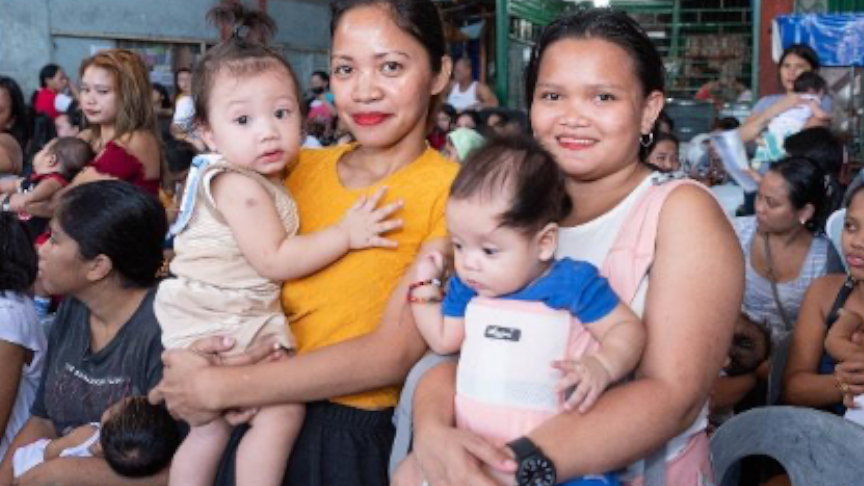NewsMakers
Interventions to reduce antibiotics require tailored approach in developing countries
A study demonstrates that contextual factors, such as local health policies, influence the results of clinical trials of medical interventions.

Fears around leaving infectious diseases untreated and poorly enforced antibiotic supply controls could hamper efforts to reduce the use of antibiotics in low to middle income countries, according to a new study from the University of Warwick.
Published in the journal Trials and led by Dr Marco J Haenssgen, Assistant Professor in Global Sustainable Development, the study demonstrates that contextual factors, such as local health policies, influence the results of clinical trials of medical interventions. The landmark study is one of the most detailed qualitative analyses of the context of clinical trials in antimicrobial resistance ever conducted. It calls for the routine collection of social data alongside clinical trials to help tailor the local appropriateness of clinical interventions and help researchers interpret their findings.
By better recording these contextual influences, the researchers argue that interdisciplinary research collaborations between the social and medical sciences can help tackle global challenges such as drug resistance more effectively.
The study analyses clinical trials in Myanmar, Thailand, and Vietnam with a total of 4,446 participants, that aimed to test the effectiveness of a five-minute finger-prick blood test to reduce antibiotic prescriptions for fever patients in primary healthcare. The test measured C-reactive protein levels in the participants’ blood, helping healthcare workers such as nurses and doctors to decide whether the cause of the febrile illness was likely to be bacterial, in which case an antibiotic could be prescribed.
The research by Dr Haenssgen’s team complemented these trials and identified differences in adherence to the results of the test in patients and clinicians, both across and within the sites – in some clinics, physicians prescribed antibiotics despite a negative test result in as much as 71% of cases. They then determined the reasons for the disparities through the analysis of nearly one million words of qualitative material from 130 interview and group discussion participants across the three countries.
They found that if antibiotics were over-abundant or if healthcare workers were worried about deadly infectious diseases they were less likely to follow the guidance provided by the biomarker test. Similarly, if long and dangerous journeys prevented patients from follow-up visits to primary health centres or if they struggled to understand the purpose of the test, then patients may be more likely to ignore the results and buy antibiotics without prescriptions from local grocery stores and pharmacies – making the intervention seemingly less effective.
The study further argues that such clinical trials could also exclude different parts of the relevant target population, as some people struggle with accessing healthcare and others might not consume antibiotics for fevers but, for instance, open wounds and other conditions for which the biomarker test is not currently being used.
Diagnostic biomarker tests are one of the main strategies to tackle drug resistant infections, which the World Health Organization named one of the “ten threats to global health in 2019.” As the World Bank warns that drug resistance could push 24 million people into poverty by 2030 and threatens the achievement of the Sustainable Development Goals, Nesta (a charity) is running the Longitude Prize challenge of £10m for the development of effective diagnostic solutions to help end the crisis.
Lead author Dr Marco Haenssgen said: “An example of how context affected clinical adherence relates to the strong antibiotic policies and the ways to manage patients without antibiotics in Thailand. Some doctors had a surprising oversupply of antibiotics to the extent that they almost felt they needed to prescribe to get rid of the surplus medicine. This was of course not the only way in which clinician adherence varied, but it shows how the same AMR intervention might or might not work, and how we need to tailor our interventions specifically for each country – one size doesn’t fit all contexts!
“For researchers, more contextual data from clinical trials means that we will be able to carry out meta-analyses to identify which contextual factor (e.g. poverty, complementary health policy) matters for the successful operation of a new intervention. That would then inform a design toolkit for clinicians that can guide them in identifying appropriate interventions, or advocating for changes in policy.
“The opportunity that presented itself to us in this research is rare – social-medical research across three low- and middle-income countries does not just require a lot of coordination and patience, but also an open-minded research team. We were fortunate to have all in place, which enabled us to inform the tools and techniques being used to fight the superbug crisis, and to advance interdisciplinary research methodologies more broadly. This wasn’t easy, but when we consider the emerging challenges to planetary health and sustainable development, interdisciplinary collaboration is the way to go.”
The social science research was led by Asst Prof Marco J Haenssgen (Global Sustainable Development at University of Warwick) in collaboration with Ms Nutcha (Ern) Charoenboon (Research Officer for the Antibiotics and Activity Spaces Project), Ms Yuzana Khine Zaw (Research Intern for the Antibiotics and Activity Spaces Project and PhD Student at the London School of Hygiene and Tropical Medicine), and Dr Nga TT Do (Researcher at the Oxford University Clinical Research Unit, Hanoi). The clinical trials were led by Prof Heiman FL Wertheim (Radboud University Medical Centre) and Prof Yoel Lubell (University of Oxford) and implemented by Dr Thomas Althaus (Mahidol-Oxford Tropical Medicine Research Unit, Bangkok) and Dr Nga TT Do.
NewsMakers
Filipinos can now gain easier access to insurance with SeaInsure and Igloo
Filipinos can now easily access various personal and family insurance plans from SeaInsure Philippines through Igloo Philippines’ AI-powered app, Ignite by Igloo.

Filipinos can now easily access various personal and family insurance plans from SeaInsure Philippines through Igloo Philippines’ AI-powered app, Ignite by Igloo.
The partnership between the two companies brings greater convenience and empowerment to insurance providers and seekers, giving Filipinos wider accessibility to essential insurance plans and supporting financial resilience.The initial products available on the app provide up to ₱300,000 worth of coverage.
These include the SeaInsure Junior Accident Shield (0 to 17 years old), which covers medical expenses resulting from accidents; the SeaInsure Ladies Accident Shield (18 to 45 years old), which provides general accident coverage, including beauty procedures and pregnancy complications; SeaInsure Personal Accident Shield (18 to 60 years old) that takes care of medical expenses from unfortunate accidents; and SeaInsure Senior Accident Shield (61 to 70 years old) that protects from accidents like slips and bone fractures.
For more information, visit https://seainsure.com.ph/products/personal/protection.
NewsMakers
PRUBabies receives back-to-back international awards
ru Life UK offered 175,000 free vouchers of PRUMedCare – Select Infectious Diseases coverage for newborns from 7 days to 11 months old, helping parents protect their newborns against the cost of getting sick from any of the covered four infectious diseases – Dengue, Typhoid, Measles and Malaria.

PRUBabies, Pru Life UK’s free insurance coverage against select infectious diseases for newborns, bagged Silver and Bronze Stevie®Awardsfor Community Relations/Public Service Communications and Innovative Achievement in Diversity & Inclusion, respectively.
As a testament to the company’s commitment to driving financial inclusion in the country, Pru Life UK offered 175,000 free vouchers of PRUMedCare – Select Infectious Diseases coverage for newborns from 7 days to 11 months old, helping parents protect their newborns against the cost of getting sick from any of the covered four infectious diseases – Dengue, Typhoid, Measles and Malaria.
“Daghang salamat Pru Life UK. Dahil sa inyo, nabigyan ng libreng proteksyon ang aking baby,” shares Jeresa Caranoo, mother from Bantayan Island, Cebu who received free insurance for her child.
Through PRUBabies, parents can receive cash assistance for the diagnosis and death of newborns due to any of the four covered diseases. The Department of Health has warned the public to watch out for the four covered diseases, particularly during summer.
The life insurer distributed free vouchers across the country through Pru Life UK’s 42,000-strong agency force and the support of local government units, non-government organizations (NGOs) and hospitals – NGO Asia Society for Social Improvement and Sustainable Transformation (ASSIST) for Bantayan Island, Cebu and Parañaque City; The CSR arm of FirstGen Corp. for its host communities in Batangas City; St. Scholastica’s Formation House in Tagaytay City; Philippine Medical Association-Calamba for Dr. Jose P. Rizal District Hospital in Calamba, Laguna; Rotary Club of Mandaluyong-Biyaya for the Grace to Be Born Shelter in Pasig City; Microfinance NGO Tulay sa Pag-unlad Inc. (TSPI) in Makati; Office of Palawan Board Member Anton Alvarez and the Mayor’s Office of Taytay for Taytay, Palawan, Rotary Club of Mandaluyong and Mandaluyong City government for the Mandaluyong City Medical Center, Manila City government for Tondo, Manila, and Barangay Council of Tandang Sora for Barangay Tandang Sora in Quezon City.
A combined financial literacy and climate & health session was also conducted for the families in Palawan, the only province in the Philippines with known malaria cases.
“PRUBabies is one of the many ways we make life insurance more accessible to more Filipino families, including babies who deserve to be protected from birth. We are grateful to our like-minded partners for their support in reaching out to unserved and underserved communities in far-flung areas. With PRUBabies, we live up to our mission to be the most trusted partners for every life and protectors for every future of Filipino families,” shares Allan Tumbaga, Pru Life UK’s Chief Customer and Marketing Officer. The free coverage vouchers have been distributed in 2023. Filipinos who want to be continuously financially protected with PRUMedCare – Select Infectious Diseases can get it via Pulse app.
NewsMakers
For people with migraine, feelings of stigma may impact disability, quality of life
For people with migraine, these feelings of stigma were linked to more disability, increased disease burden and reduced quality of life.

Migraine can impact many aspects of a person’s life, but less is known about how feelings of stigma about the disease affect quality of life. For people with migraine, these feelings of stigma were linked to more disability, increased disease burden and reduced quality of life, according to new research published in the online issue of Neurology, the medical journal of the American Academy of Neurology.
“Stigma is common where the disease is not readily apparent to others, and there is indication that it could be especially relevant for those living with migraine,” said study author Robert Evan Shapiro, MD, PhD, of the University of Vermont and Fellow of the American Academy of Neurology. “This stigma may arise when a person with migraine recognizes negative stereotypes about the disease and experiences shame for having the disease, fear of experiencing stigma from others, or other negative emotions.”
For the study, researchers looked at 59,001 people with migraine with an average age of 41. Among all participants, 41% reported experiencing four or more headache days per month on average.
Participants answered 12 questions to assess two types of stigma: whether they felt others viewed migraine being used for secondary gain and whether they felt others were minimizing the burden of migraine. Questions included “How often have you felt that others viewed your migraine as a way to get attention?” “… as something that made things difficult for your co-workers or supervisor?” and “…with a lack of understanding of the pain and other symptoms?”
Researchers found that 32% of the participants experienced migraine-related stigma often or very often.
To assess migraine-related disability, participants reported the number of days they missed or had reduced productivity at work, home or social events over the previous three months. High scores on migraine-related stigma were linked with moderate to severe disability. Three-quarters of those who experienced stigma often or very often had moderate to severe disability, compared to 19% of those who never experienced stigma.
They also took a test assessing migraine-specific quality of life, which looked at the impact of migraine on social and work-related activities over the previous four weeks. Scores ranged from zero to 100 with higher scores meaning higher quality of life. Researchers found that those who experienced the highest rates of migraine-related stigma scored far lower in these tests, with an average score of 35 compared to those who did not experience stigma with an average score of 69.
The results remained the same after researchers adjusted for other factors that could affect disability and quality of life, such as age, employment status, other medical conditions and frequency of migraines.
They also found that the amount of stigma experienced increased with migraine severity. Those with 8-14 headache days or more than 15 monthly headache days were far more likely to report at least one form of stigma with 42% and 48%, respectively, compared to those with less than four monthly headache days with 26%.
“The social context of migraine may have a greater impact on quality of life than the number of monthly headache days,” said Shapiro. “However, it is possible that connecting with others with migraine may help decrease migraine-related stigma and stereotypes. More studies are needed to explore the mechanisms that link stigma to health outcomes.”
A limitation of the study was that participants self-reported their migraines, based on a questionnaire or a diagnosis from a health care provider, and they may not have remembered all the information accurately.
-

 NewsMakers3 weeks ago
NewsMakers3 weeks agoPru Life UK solidifies position as top life insurer in PH
-

 NewsMakers4 weeks ago
NewsMakers4 weeks agoMeat-free wonder with Pizza Hut’s flavorful seafood options
-

 Travel4 weeks ago
Travel4 weeks agoTips to prep your motorcycle for safe road trips
-

 Product Showcase4 weeks ago
Product Showcase4 weeks agoHow tailored microinsurance products are key to relevance and adoption in PH
-

 NewsMakers3 weeks ago
NewsMakers3 weeks agoSiemens Healthineers turnover Letters of Intent to PH gov’t
-

 Destinations2 weeks ago
Destinations2 weeks agoSingapore Cable Car launches world’s first Skyorb Cabins
-

 NewsMakers1 week ago
NewsMakers1 week agoGolden Visa Centrale to hold consultation roadshow on Greek Golden Visa program
-

 Home Care4 weeks ago
Home Care4 weeks agoHow to check for bed bugs


















